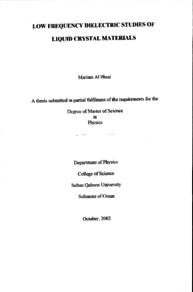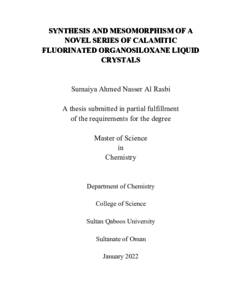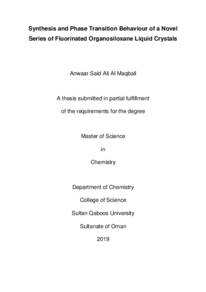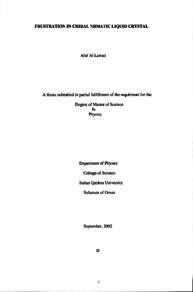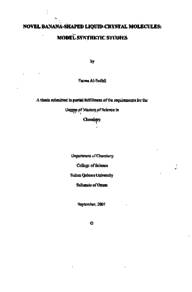Document
Low frequency dielectric studies of liquid crystal materials.
Publisher
Sultan Qaboos University
Gregorian
2002
Language
English
Subject
English abstract
Low frequency dielectric investigations have been carried out on two thermotropic liquid crystal materials. The first one, viz., E7 exhibited nematic phase while the second one is a ferroelectric liquid crystal which exhibited SmA and SmC* phases. The nematic loss spectrum exhibits a single relaxation, which corresponds to the molecular rotation around the short axis. The activation energy (1.64 eV) estimated from the reduced temperature plots reflects the strong orientational coupling tuned by terminal Cyano-group. The Cole-Cole plots drawn at different temperatures support the increasing effective response of the low frequency (80) end of the spectrum with decreasing temperature and the distribution parameter a confirms the resumption of the nematic orientational order with decreasing temperature. The loss spectrum in the ferroelectric liquid crystal is found to accompany with two relaxation processes (one at -600Hz and another at -6.2MHz in SmA phase and two relaxations in SmC* phase at frequencies ~250Hz and ~4.9MHz. All the relaxations follow the Arrhenius shift from which the activation energy of each mode is calculated. The temperature and voltage variations of the (low-frequency, helix related) Goldstone mode relaxation of SmC* phase are studied. While the SmC* soft mode relaxation frequency in MHz relevant to the tilt of the molecules) is found to increase with decreasing temperature, the SmA soft mode relaxation frequency is found to decrease with decreasing temperature. The temperature variation of the dielectric strength, Aε = [ɛo-Ec] pertaining to the SmA soft mode relaxation inferred the growth of ferroelectric SmC* following Curie Weiss law across AC* transition.
Member of
Resource URL
Arabic abstract
تمت دراسة اثنان من المواد البلورية السائلة عن طريق العزل الكهربائي ذو التردد المنخفض. المادة الأولى هي مادة (E) التي تظهر حالة نيماتك (Nematic ) والثانية هي من المواد البلورية السائلة المستقطبة وهي تظهر كل من حالتي (SmecticA ) و (*SmecticC). طيف الفقدان للمادة الأولى اظهر معدل تراخي مفرد حسب دوران الجزيئات حول محورها القصير أثناء توجهها مع المجال الكهربائي. الطاقة الفعالة لهذا التراخي والتي حسبت من التمثيل البياني للوغاريتم الطبيعي التردد التراخي مع درجات الحرارة هي 1 . 64 الكترون فولت وهي تعكس التأثير القوي لمجموعة السيانيد في طرف الجزيء أثناء توجهاته مع المجال. إن رسومات کول کول ( Cole - Cole ) لدرجات الحرارة المختلفة تؤكد الاستجابة المتزايدة لطرف التردد المنخفض للطيف مع انخفاض درجة الحرارة وقيمة معامل التوزيع 0 تؤكد بقاء ترتيب الجزيئات في حالة ( Nematic ) مع انخفاض درجة الحرارة طيف الفقدان للمادة الثانية تصاحب بعمليتي تراخي في حالة (SmecticA) الأولى عند تردد حوالي 600 هيرتز والثانية عند حوالي 6 . 2 ميجاهيرتز و عملتين أخريتين في حالة (*SmecticC) عند التردد حوالي 250 هيرتز و حوالي 49 ميجاهيرتز وجميعها وجدت أنها تتبع معادلة أرهينيس (Arrhenius). وقد درست عملية التراخي ذات التردد المنخفض في حالة (*SmecticC) والمسماة بعملية الحجر الذهبي قد درست مع تغيير فرق الجهد بالإضافة إلى درجة الحرارة. كما وجد أنه بينما يرتفع تردد التراخي للعملية ذات التردد العالي مع انخفاض درجة الحرارة في حالة (*SmecticC) ينخفض في حالة (SmecticA). ووجد أيضا أن تغير قوة العزل الكهربائي لهذا التراخي مع تغير درجة الحرارة في منطقة التحول من حالة (SmecticA) إلى حالة (*SmecticC) يتبع قانون کیوري وایس ( Curie
Category
Theses and Dissertations

